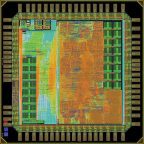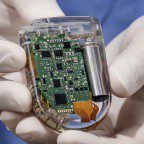 This piece is part of Design World’s 10th Anniversary special for October 2016, where we take a look at how far design engineering has come in the last decade … and how far it will go by 2026.
This piece is part of Design World’s 10th Anniversary special for October 2016, where we take a look at how far design engineering has come in the last decade … and how far it will go by 2026.
If you’re leery about riding in a car sans steering wheel, you’ve got company. But everyone from Google and Apple to Tesla Motors and Uber to Delphi and Daimler to the National Highway Traffic Safety Administration (NHTSA) is banking on the coming tide of autonomous vehicles.
Cars ruled this year’s Consumer Electronics Show, and in 2017 they’ll get a designated Autonomous Vehicles Marketplace. Audi engineers showcased zFAS controllers and how they’ve optimized radar sensors for drive-assist functions (which in turn are proving grounds for autonomous-vehicle utilities). Likewise, Ford detailed its driverless fleets’ use of light-based LiDar PUCKs from Velodyne, $8,000 3D sensor arrays that scope areas to 200 meters at centimeter-level accuracy in realtime, with more than two million data points per second. Most innovative is their replacement of spinning lasers with solid-state sensors.
In fact, three main sensing technologies—cameras, radar of various scopes, and LiDar—give today’s autonomous vehicles environmental feedback. These complement controllers running algorithms based on recorded tracks of machine learning called deep learning—a relatively new branch of adaptive programming—to navigate countless driving scenarios involving traffic signs, road conditions, vehicles, and pedestrians. Ever-improving vehicle-to-vehicle communications, superfast wiring architectures, advanced navigational mapping, and artificial intelligence spurred by military applications and Defense Advanced Research Projects Agency (DARPA) competitions are other options for autonomous-vehicle automakers. As there’s commonality between the smarts of self-driving and electric car functions, many predict a specific trend towards driverless electric cars.
BMW, Toyota, GM, and Nissan say they’ll offer autonomous cars by 2020 or sooner. U.S. Secretary of Transportation Anthony Foxx anticipates self-driving cars in use globally by 2025. So within the next decade, driverless-car technology will come to change the way we move about the world—and change how we conceptualize transportation. It will eliminate jobs associated with movement of goods … and force truck and taxi drivers to yield (pun intended) to efficiency. It will give new mobility to the elderly and disabled. It will streamline delivery services and roadway policing. It will bestow more free time to commuters and enable flexible car-sharing. It will (with anonymized traffic feedback to the cloud) prompt optimization of roadways and related infrastructure. It will abolish parking-lot space hunting and prompt the insurance industry to resize itself.
Most importantly, self-driving technologies will prevent some of the million-plus automobile deaths caused annually by driver confusion, distraction, frustration, and drunkenness.
On Valentine’s Day this year, a Google car collided with a bus in a minor traffic accident. No one was hurt, but this first-ever fleet failure underscores that no technology outputs perfect results. As we adjust to autonomous vehicles on our roads, the tragic inevitability of roadway deaths will confront us with that limitation. When this happens, let us remember how driverless cars will save a great many more from the perils of human error.  By 2026, new AI we can’t now fathom will make our most dangerous daily activity safer, all thanks to their use in driverless cars.
By 2026, new AI we can’t now fathom will make our most dangerous daily activity safer, all thanks to their use in driverless cars.
Related: Lee Teschler’s Robots will build spacecraft in orbit
Related: Paul Heney’s Looking to the future of AI … in 2026
Related: Mary Gannon’s A new (and old) way to look at STEM education
Related: Miles Budimir’s Sorry, but technology won’t save us
Related: Leslie Langnau’s Can you think differently?







Leave a Reply
You must be logged in to post a comment.